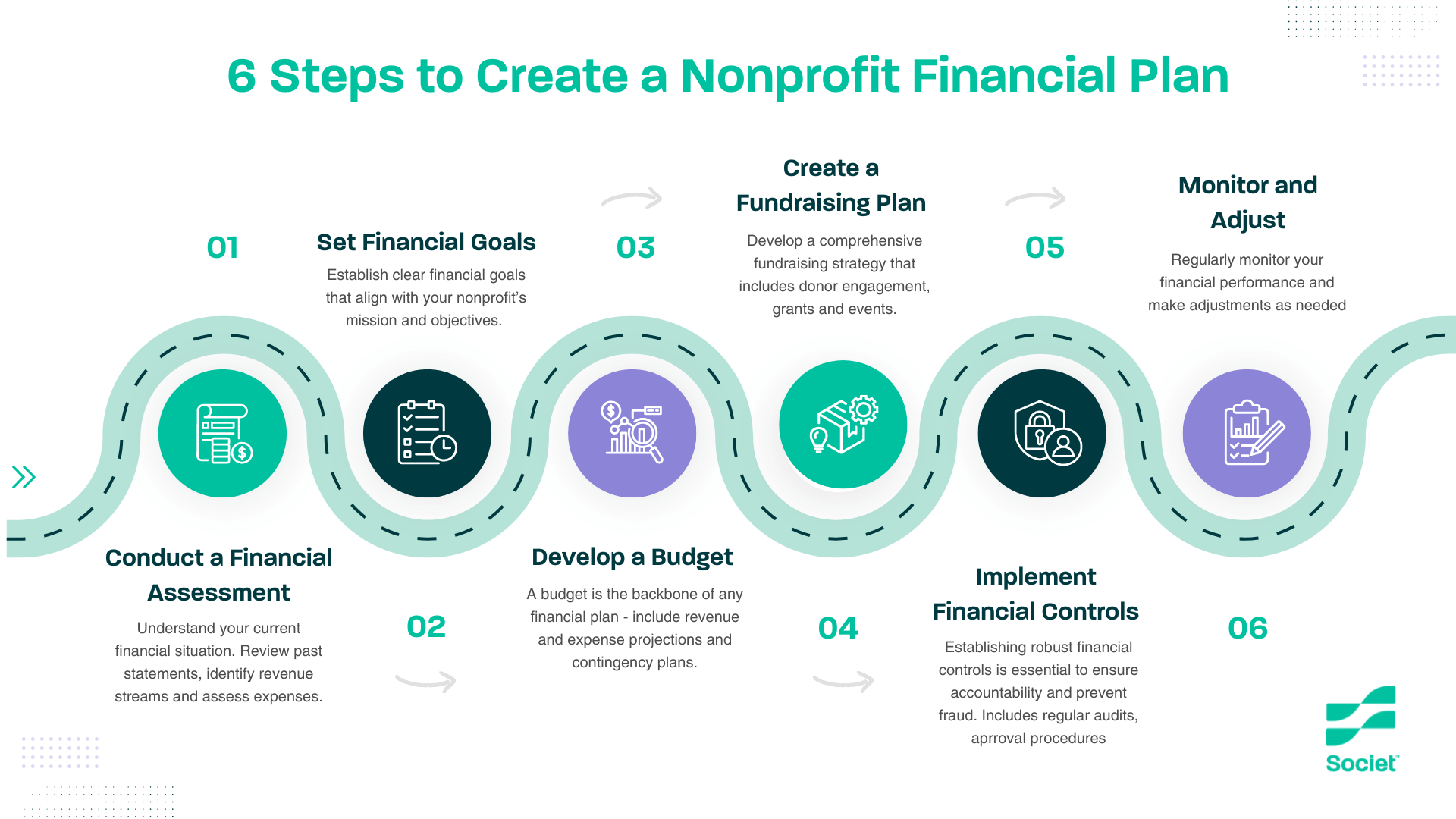
Creating a financial plan for nonprofit organizations is a crucial step in ensuring sustainability and achieving your mission. Whether you’re just starting out or looking to refine your existing strategies, a well-crafted financial plan can help you secure funding, manage resources efficiently, and demonstrate accountability to stakeholders. In this comprehensive guide, we’ll walk you through the essential steps and best practices for creating a robust financial plan for your nonprofit.
We’ll cover the following:
Why a Financial Plan is Essential
A financial plan for nonprofit organizations serves multiple purposes:
- Attracting Funding: Potential donors, grant-making bodies, and loan providers need to see a clear picture of your financial health and future projections.
- Resource Management: A financial plan helps you allocate resources efficiently, ensuring that every dollar is used effectively to support your mission.
- Accountability: Transparency in financial planning builds trust with stakeholders, including donors, board members, and beneficiaries.
- Sustainability: It provides a roadmap for long-term sustainability, helping you navigate financial challenges and seize opportunities for growth.
Steps to Create a Financial Plan for Nonprofit Organizations
1. Conduct a Financial Assessment
Before diving into the planning process, it’s essential to understand your current financial situation. This includes:
- Reviewing Past Financial Statements: Analyze your income statements, balance sheets, and cash flow statements from the past few years.
- Identifying Revenue Streams: Determine where your funding has come from, such as donations, grants, membership fees, and fundraising events.
- Assessing Expenses: Break down your expenses into categories like salaries, program costs, administrative costs, and fundraising expenses.
2. Set Financial Goals
Establish clear financial goals that align with your nonprofit’s mission and strategic objectives. These goals could include:
- Revenue Targets: Set specific targets for each revenue stream, such as increasing donations by 20% or securing three new grants.
- Expense Management: Identify areas where you can reduce costs without compromising the quality of your programs.
- Surplus and Reserves: Plan for a surplus to build financial reserves, ensuring stability during lean periods.
3. Develop a Budget
A well-structured budget is the backbone of any financial plan for nonprofit organizations. Your budget should include:
- Revenue Projections: Estimate the income you expect from various sources, based on historical data and realistic assumptions.
- Expense Projections: Outline your expected expenses, categorized by program, administrative, and fundraising costs.
- Contingency Plans: Include a contingency fund to cover unexpected expenses or revenue shortfalls.

4. Create a Fundraising Plan
Fundraising is a critical component of your financial plan. Develop a comprehensive fundraising strategy that includes:
- Donor Engagement: Build strong relationships with existing donors and identify potential new donors.
- Grant Applications: Research and apply for grants that align with your mission.
- Fundraising Events: Plan and execute events that can generate significant revenue.
- Online Fundraising: Utilize digital platforms and social media to reach a broader audience. Need help? Frontier nonprofit marketing agency has helped nonprofits raise tens of millions over the last decade.
5. Implement Financial Controls
Establishing robust financial controls is essential to ensure accountability and prevent fraud. Key controls include:
- Segregation of Duties: Ensure that different individuals handle different aspects of financial transactions to prevent conflicts of interest.
- Regular Audits: Conduct internal and external audits to verify the accuracy of your financial records.
- Approval Processes: Implement approval processes for expenses and financial decisions to maintain oversight.
6. Monitor and Adjust
A financial plan for nonprofit organizations is not a static document. Regularly monitor your financial performance and make adjustments as needed:
- Monthly Reviews: Review your financial statements monthly to track progress toward your goals.
- Quarterly Reports: Prepare quarterly financial reports for your board of directors and key stakeholders.
- Annual Reviews: Conduct a comprehensive annual review to assess your financial health and make strategic adjustments.
Example: Financial Plan for a New Nonprofit
Let’s walk through an example of creating a financial plan for a new nonprofit organization focused on providing educational resources to underserved communities.
Step 1: Financial Assessment
As a new nonprofit, you won’t have past financial statements. Instead, research similar organizations to understand typical revenue streams and expenses. For instance, you might find that similar nonprofits receive funding from grants, individual donations, and corporate sponsorships.
Step 2: Set Financial Goals
- Revenue Targets: Secure $50,000 in grants, $30,000 in individual donations, and $20,000 in corporate sponsorships in the first year.
- Expense Management: Limit administrative costs to 10% of total expenses and allocate 70% of the budget to program costs.
- Surplus and Reserves: Aim for a 5% surplus to build a financial reserve.
Step 3: Develop a Budget
- Revenue Projections: $50,000 from grants, $30,000 from individual donations, $20,000 from corporate sponsorships.
- Expense Projections: $70,000 for program costs, $10,000 for administrative costs, $20,000 for fundraising expenses.
- Contingency Plans: Set aside $5,000 for unexpected expenses.
Step 4: Create a Fundraising Plan
- Donor Engagement: Develop a donor engagement strategy, including personalized thank-you notes and regular updates on the impact of their contributions.
- Grant Applications: Identify and apply for relevant grants, such as those from educational foundations and government agencies.
- Fundraising Events: Plan an annual gala and a community fun run to raise funds and increase visibility.
- Online Fundraising: Launch a crowdfunding campaign and leverage social media to reach potential donors.
Step 5: Implement Financial Controls
- Segregation of Duties: Assign different team members to handle donations, recordkeeping, and financial reporting.
- Regular Audits: Schedule quarterly internal audits and an annual external audit.
- Approval Processes: Require dual approval for expenses over $500 and board approval for major financial decisions.
Step 6: Monitor and Adjust
- Monthly Reviews: Review financial statements monthly to track revenue and expenses.
- Quarterly Reports: Prepare quarterly financial reports for the board and key stakeholders.
- Annual Reviews: Conduct an annual review to assess financial performance and make strategic adjustments.
Leveraging Technology for Financial Planning
In today’s digital age, leveraging technology can significantly enhance your financial planning efforts. Solutions like Sumac CRM and Sumac Donations can streamline your financial management processes, making it easier to track donations, manage donor relationships, and generate financial reports.
Sumac CRM
Sumac CRM is a powerful nonprofit CRM designed specifically for nonprofits. It helps you manage donor information, track donations, and generate detailed financial reports. With Sumac CRM, you can:
- Centralize Donor Data: Keep all donor information in one place, making it easy to track contributions and engagement.
- Automate Reporting: Generate financial reports with just a few clicks, saving time and reducing errors.
- Enhance Donor Engagement: Use the CRM to segment donors and personalize communication, increasing donor retention and engagement.
Sumac Donations
Sumac Donations is a comprehensive donor management software that simplifies the donation process and provides valuable insights into your fundraising efforts. With Sumac Donations, you can:
- Streamline Online Donations: Accept donations through your website and automatically record them in your system.
- Track Fundraising Campaigns: Monitor the performance of your fundraising campaigns and identify areas for improvement.
- Generate Financial Reports: Access detailed reports on donation trends, donor demographics, and campaign performance.
Conclusion
Creating a financial plan for nonprofit organizations is a vital step in ensuring sustainability and achieving your mission. By conducting a thorough financial assessment, setting clear goals, developing a budget, and implementing robust financial controls, you can build a strong foundation for your nonprofit’s financial health. Regular monitoring and adjustments will help you stay on track and navigate any challenges that arise.
Leveraging technology solutions like Sumac CRM and Sumac Donations can further streamline your financial planning efforts, making it easier to manage donor relationships, track donations, and generate insightful reports. With a well-crafted financial plan and the right tools, your nonprofit can thrive and make a lasting impact on the communities you serve.
If you’re ready to take your financial planning to the next level, explore our nonprofit CRM and donor management software today. Let’s work together to build a brighter future for your nonprofit and the causes you care about.


